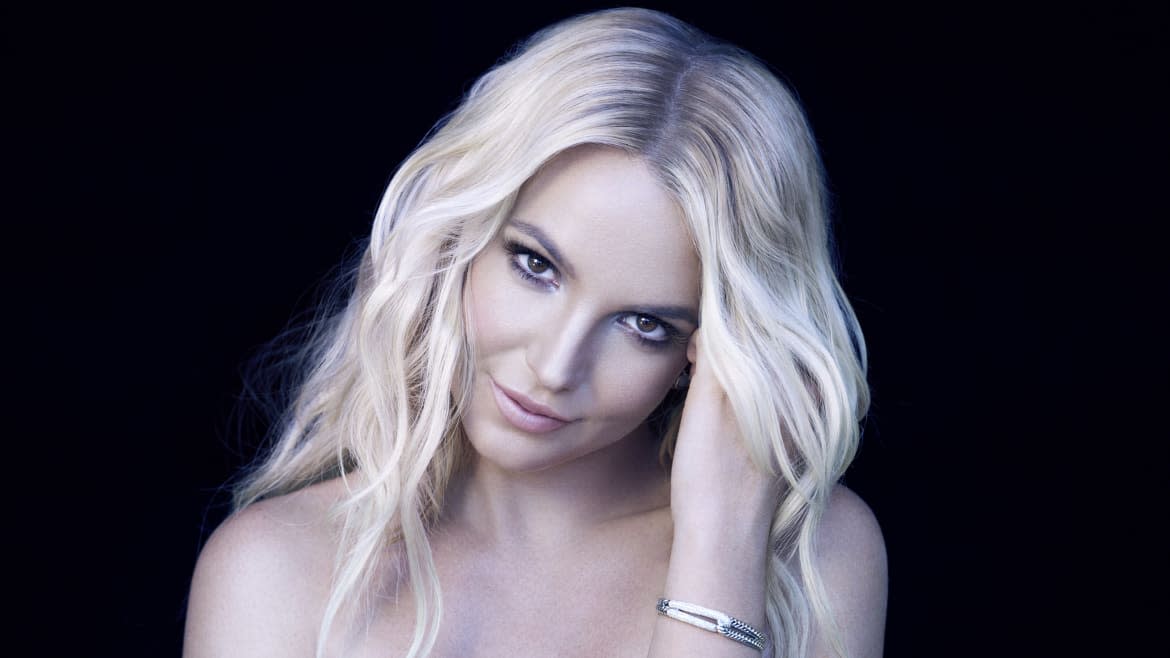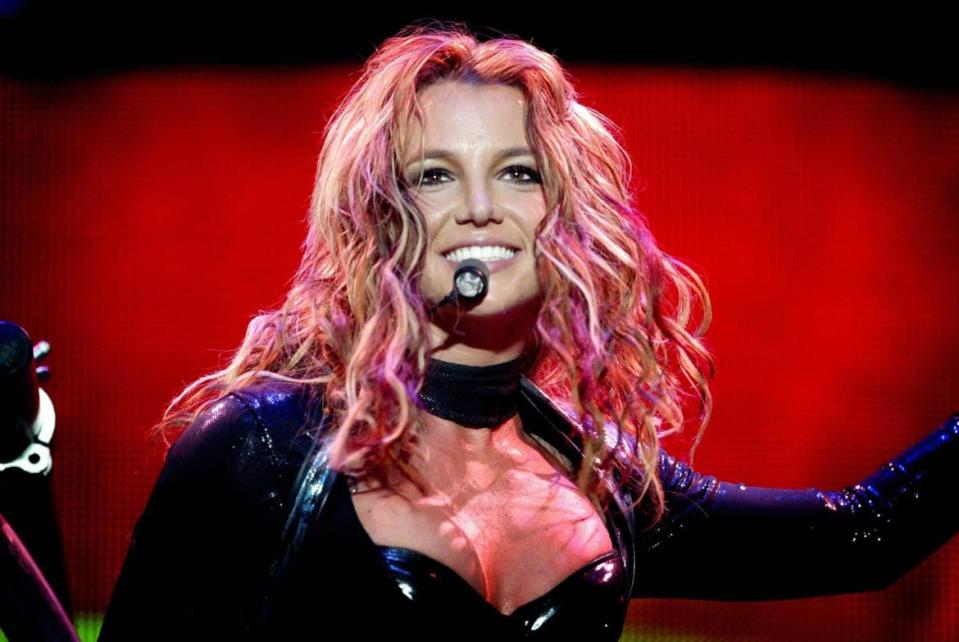How the Media Smeared Britney Spears as ‘White Trash’

- Oops!Something went wrong.Please try again later.
- Oops!Something went wrong.Please try again later.
In 2008, the same year that Britney Spears had been placed under a 5150 psychiatric hold after losing custody of her children amid a painful, tabloid-fueled public breakdown, a gaggle of Family Feud contestants took turns guessing at all the things she’d lost. Her hair? Ding! Her husband? Ding! Her sanity? Host John O’Hurley’s voice boomed with classic game show boisterousness as he shouted, “Has she lost her mind?!” Ding! Other answers included “Her Children” and “Weight”—to which O’Hurley replied, “I guess...”
More than a decade later, the clip is just one of countless pieces of chilling archival footage included in The New York Times’ explosively popular documentary Framing Britney Spears—which explores the singer’s life and career within the context of the fan-led movement to free her from the conservatorship that has ruled her life for more than a decade.
Available on Hulu following its debut on FX, Framing Britney Spears builds on the multiple robustly reported articles the Times has run over the years—each of which have lent gravitas to a fan effort that might otherwise have been written off—and is a handy primer for anyone who’s still not quite sure what cries to #FreeBritney actually mean. But its study of the singer’s life and career in the public eye feels rushed and even superficial at times. Despite the doc’s insistence that “to understand where Britney is now, we should understand how she got here,” the episode itself offers a cherry-picked biography—one that oversimplifies the many societal impulses that converged to dehumanize and torment a young celebrity in distress.
The #FreeBritney Movement Is About to Become a War
In analyzing how Spears came to be treated with such cruelty, Framing Britney Spears rightly dissects the misogyny she faced from just about everyone throughout her career—from the older men interviewing her with probing questions about her sex life and breasts during her teen years, to the interview in which Diane Sawyer reduced a 22-year-old Spears to tears in primetime by asking what she had “done” to break Justin Timberlake’s heart. (Sawyer also seemed to defend the then-first lady of Maryland for saying she’d shoot Spears if given the opportunity, telling the appalled singer, “It’s because of the example for kids and how hard it is to be a parent.”) We also witness the ways in which Timberlake was able to seize the narrative of his break-up with Spears, who got labeled the “school slut” after rumors emerged that she had cheated on the NSYNC singer with choreographer Wade Robson.
Misogyny certainly poisoned Spears’ relationship with celebrity, but Framing Britney’s examination of the horrible treatment hurled her way feels limited—reliant, above all, on the idea that misogyny is a fixed ideology. In reality, misogyny comes in different flavors, depending on other factors including but certainly not limited to a woman’s race, social class, gender expression, and weight. To understand how Spears “got here,” her womanhood is just one of several facets of her identity one must unpack.
For instance: How can we talk about the dehumanization of Britney Spears if we never address how her image morphed from that of a darling “small-town girl” from the South, to that of a backwards “white-trash” redneck who deserved no sympathy from the public?
As with any project concerning Spears, Framing Britney doesn’t waste much time before reminding us all that she hails from the modest town of Kentwood, Louisiana. Overhead shots of the Kentwood water tower, farmland, and a church steeple play like a screen-saver as the bubbly, heavily accented Felicia Culotta—Spears’ assistant and chaperone for years—explains the town’s “hospitable and humble” nature. Kentwood was central to Spears’ public image from her early years; her parents, James (AKA “Jamie”) and Lynne Spears, famously scraped by to fund their eldest daughter’s career, even as the former’s contracting business collapsed.
In Spears, America had found yet another talented youngster to pluck from poverty and catapult into the glitzy, glamorous world of celebrity. But even as Spears’ Southern, working-class background initially allowed her to flourish as the exemplar of the American dream, the singer’s subsequent refusal to play by a very specific set of rules earned her several denigrating labels, many of which seemed to be attached to lower-income communities within the Bible Belt.
Jennifer Musial, assistant professor of women’s and gender studies at New Jersey City University, offers a compelling theory as to how this happened. “Celebrity is meant to elevate rural white Southerners,” she writes, “and here ‘elevate’ means to save from their perceived ‘backwardness.’ Spears failed to be the ‘right’ kind of Southerner that we (are supposed to) root for.”
“If celebrity is the perfect marriage between neoliberal capitalism and the American Dream because it promises anything is possible, then pop star Britney Spears exposes the fissures of an idealized system,” Musial writes. “Spears shows us that not everyone can be transformed and that public shaming awaits those whose behavior betrays what is expected of affluent white women.”
From the release of “...Baby One More Time” and its Catholic schoolgirl-themed video in 1998 onward, Spears faced a relentless barrage of criticism and concern trolling—but rather than cover her midriff or tone down her videos, the singer did the opposite. In 2001, she released the steamy video for “I’m a Slave 4 U” and danced at the MTV Video Music Awards draped in a giant anaconda and not much else. That she dared to do so while still claiming to be a virgin was too much for many apoplectic adults at the time to handle.
As Musial notes, Spears often invoked Kentwood as a reason for her provocative fashions. In Heart-to-Heart, which Spears co-wrote with her mother in 2000, the singer writes, “The crop tops and hip huggers I wore in some of my videos were the kind of clothes we used to wear in Kentwood (it can be scorching during the summer, so the barer the better!), and I’m real comfortable dancing in them.”
The public wasn’t necessarily convinced, but Spears’ power over her captive public was undeniable—and derived, at least in part, from a Lolita image that she and her management sculpted flawlessly for years. But when Spears became pregnant with her and Kevin Federline’s first son, Sean Preston, in 2005, the tightrope she’d been walking disappeared from under her.
It’s difficult to discern why Framing Britney Spears skips straight from Spears’ break-up with Timberlake in 2002 to her engagement to Federline two years later. In doing so, the doc ignores multiple relationships that ignited the public derision toward her in earnest—like her brief dalliance with her back-up dancer, Columbus Short, and her infamously brief marriage to childhood friend Jason Alexander (not of Seinfeld fame) in 2003. It was right around when Spears married Alexander, Musial notes, that more and more publications began to slap Spears with the label “white trash”—especially after reports emerged that she’d worn a baseball cap and ripped jeans down the aisle.
Then came Federline, whom Spears married in 2004 after three months of courtship. Hitching her wagon to a white dancer with cornrows, who’d only just separated from the mother of his two children (one of whom was still in utero), did little to alleviate the scrutiny on Spears and her perceived “trashiness.” The singer’s make-out sessions with Federline on their balcony, one of which included Spears performatively grabbing her beau’s crotch for the hordes of tireless cameras below, were strewn across tabloids as proof of the couple’s tastelessness.

Britney Spears leaves the Los Angeles County Superior courthouse after a child custody status hearing on May 6, 2008. Spears has been locked in a custody feud with her former husband Kevin Federline since the couple split in 2006.
As Vanessa Grigoriadis put it in Rolling Stone in 2008, “Federline gave Britney license to fully embrace her white-trash side—walking into gas-station restrooms barefoot, dumping ashtrays out hotel windows, wearing novelty tees like I’m a virgin, but this is an old shirt and, most notably, not strapping the kids into car seats.”
The classist labels thrown at Spears furthered her tabloid-driven and, yes, deeply sexist dehumanization—and things only got worse when she announced her pregnancy. The singer’s body, which she had meticulously maintained for years with a grueling gym regimen topped off with 1,000 daily crunches, transformed from a locus of power to a liability.
Until her pregnancy, Spears had successfully leveraged America’s collective worship of her impossible figure to maintain control over her broader career and public image—but as late-night shows and tabloids alike cruelly mocked the singer’s weight gain, that power began to dissolve. (After all, is there anything this country loves more than telling mothers, especially those associated with lower-income backgrounds, how to raise their kids?)
Rumors swirled that Spears was drinking and smoking throughout her pregnancy, allegations that she denied. Various publications littered their pages with photos of Spears eating burgers and Cheetos, with close-ups of the stains on her shirt and the acne on her skin—a maneuver used to imply that she lacked proper discipline. And once Spears gave birth, things only got worse after she was photographed driving with her infant son on her lap and, on another occasion, tripping with him in her arms and a glass of water in her hand.
Being watched so closely, and so unforgivingly, for so long took a visible toll on Spears, whose 2006 interview with Matt Lauer, also seen in Framing Britney, is painful to watch. At one point, as seen in the doc, Lauer asks Spears, “What do you think it will take to get the paparazzi to leave you alone?” She begins to cry, repeating the words, “I don’t know.”
But another moment unseen in the documentary is, perhaps, even more illuminating. Lauer eventually asks Spears how her image went from “this great, young thing from the South” to that of a “redneck.”
“I think that’s just cruel, you know?” Spears replied. “... I feel like when you put labels on people like that... At the end of the day, they’re just words. And that’s what I have to look at them as. You have to be really strong and just be like, ‘If that’s what you wanna say, then, you know, OK.’” She also addressed the driving incident, saying that her father had done the same with her when she was young. “I’d sit in his lap and drive,” she said. “We’re country.”
Despite Spears’ candor, and her visible emotional struggle, the response to the interview was cruel—and, once again, steeped in classist resentment. A sample, from Robin Givhan of The Washington Post:
“The Britney Spears interview on NBC’s Dateline offered several lessons worth noting, the most significant of which is to remove large wads of gum from one’s mouth before engaging in a conversation,” Givhan wrote, adding later, “It is also best not to wear a denim miniskirt so short that when seated it practically disappears beneath the protuberance of one’s pregnant belly, producing an image that is more gynecological than fashionable. Instead of making a statement about the sexiness of impending motherhood, it suggests that the mother-to-be appears to be unfamiliar with the usefulness of a full-length mirror and the term ‘ho-gear.’”

Britney Spears performs in Rotterdam on May 7, 2004, during her sole concert in the Netherlands for her "The Onyx Hotel Tour."
The piece, which at one point says Spears looked like a “stereotypical hick,” grants that her tearful plea to be left alone was compelling, but adds that it was “hard to concentrate” on her emotional torment because of her “over-bleached and uncombed” hair and loud make-up: “If the point of the interview was to curry sympathy and concern from viewers, then Spears reached for a costume to make her pitch.”
The tumult that would follow Spears’s Lauer interview has been well documented—a divorce from Federline in 2006, soon after the birth of their second son Jayden James months earlier; partying with Paris Hilton; losing custody of her children; multiple stints in rehabilitation centers; and a disastrous 2007 MTV VMAs performance of “Gimme More”—which prompted more body-shaming—a 5150 psychiatric hold, and eventually, the conservatorship. (In 2007, Spears’ younger sister, Jamie Lynn, announced her own pregnancy at the age of 16, which only intensified the public’s scrutiny toward the family.)
In addition to its rushed biography, Framing Britney Spears is also peculiarly simplistic in describing conservatorship as typical among the elderly—which ignores the number of disabled people who are also subject to guardianship. This, too, feels like a missed opportunity to contextualize Spears’ struggle within that of the state’s dehumanization of disabled people.
Speaking with The Daily Beast last August, Zoe Brennan-Krohn, staff attorney with the ACLU’s Disability Rights Project, noted it’s much easier to get in a conservatorship than it is to get out of one. “There’s an inherent harm in stripping someone of their civil rights and liberties, and there is a signaling harm in telling a person, ‘You are not smart enough, trustworthy enough, healthy enough, well enough, to direct your own life,’” she explained.
Spears and her family have never disclosed a formal diagnosis for the singer, who has discussed dealing with anxiety in the past but declined to say much more about her mental health. But there’s also no need to speculate in order to make the comparison. As IndieWire’s Kristen Lopez points out in a recent piece addressing the documentary’s choice to ignore the disability community, “when you factor in the more nefarious ways conservatorships control a person’s medical and, especially, sexual and reproductive health, it’s reminiscent of the numerous ways those with disabilities have been controlled and prohibited from being considered actual people.”
One could argue that Framing Britney’s simplifications are largely a factor of runtime. As the sixth episode in The New York Times Presents’ second season, it is also the longest entry so far, clocking in at around 74 minutes. For those who simply want to understand what all the #FreeBritney fuss is about, the documentary is undeniably useful, but its investment in brevity squanders the opportunity to say anything deeper with its subject’s story—a biography that speaks, in so many ways, to the tensions that still underpin our society, even if celebrity reporting has gotten a little more polite. In truth, even with more time, it will probably be impossible for anyone to properly tell Spears’ story without the participation of the Princess of Pop herself. Either way, if there’s anyone whose story merits a deeper, more complex approach, it’s Britney, bitch.
Get our top stories in your inbox every day. Sign up now!
Daily Beast Membership: Beast Inside goes deeper on the stories that matter to you. Learn more.

